 |
Vendredi 31 octobre 2025 - 07:11 |
| Translate |
|
| Rubriques |
| Réseaux sociaux |
|
| Liste des jeux Amiga |
|
| Trucs et astuces |
|
| Glossaire |
|
| Galeries |
|
| Téléchargement |
|
| Liens |
|
| Partenaires |
|
| A Propos |
|
| Contact |
|

|
|
The Amiga's graphics capabilities earned it a place in scientific applications. Now, with accelerated hardware, specialized software, and networking features, the Amiga, is more capable than ever.
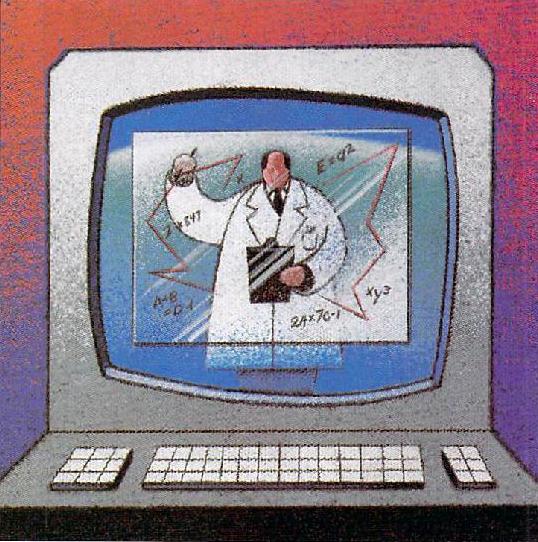
When we started to dig for information on the Amiga's role in science, we got more than we bargained for, finding more applications than we could possibly cover in one article. Keep your eyes on the Overscan section of future issues for reports on more scientific applications. For now, though, let's take a stroll through a few sites where the Amiga has earned respect as a serious scientific tool.
Lawrence Livermore Labs
It should come as no surprise to find that the slide show in the Visitors' Center at Lawrence Livermore Lab was done on an Amiga 500, or that the Livermore Computer Center's slide show was produced with an A2000HD. After all, the Amiga is known for its graphics prowess.
It might surprise some, however, to learn that the Amiga is playing a role in Livermore's fusion research; that it is helping to develop the "eyes" of satellites looking for missiles; that it is plotting electrical fields and particle trajectories.
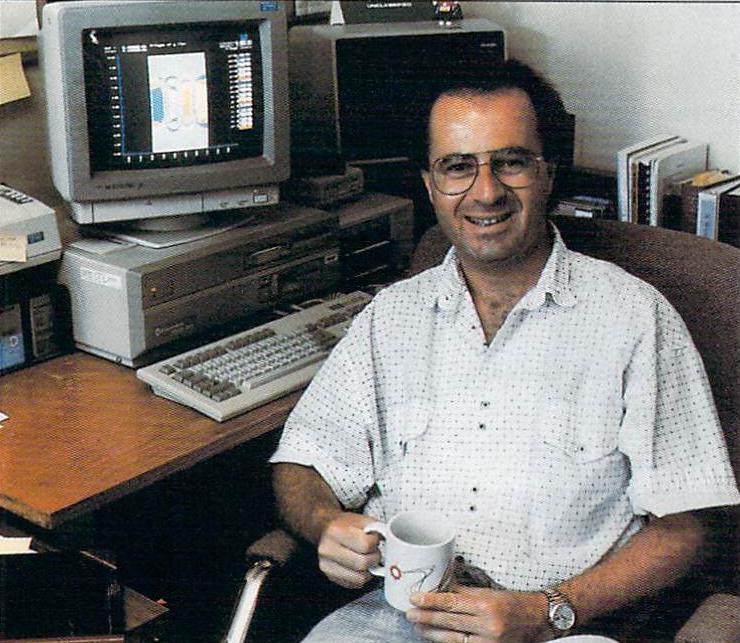
High-energy physicist Craig Wuest displays Cray-processed data on his A2000
Schoenberger is currently testing Commodore's Amiga Unix V.4 to see how it behaves in this complex, Cray-centered network. He reports that it is doing wonderfully. In a network situation such as this, having a computer that is adept at graphics is a big plus, says Schoenberger.
Livermore has been researching fusion, wherein hydrogen isotopes blasted by lasers implode, changing into helium. Fusion, the energy released in this conversion, produces a greater yield and releases less radioactivity than fission - and thus offers promising potential as an energy source.
Though the explanation may be somewhat simple, the process is not. The conditions must be exactly right for conversion to occur, and the calculations involved are extremely complex. The number-crunching Cray is irreplaceable, but the Amiga makes it easy to "see" what is going on.
Simulations run on the Cray are downloaded to an Amiga workstation, where they are displayed in 2-D animations via GfxBase's X Windows. "The Amiga can present animation in a fluid form better than a Macintosh or IBM," says Schoenberger. It can show a cross-section of the hydrogen bead along with temperature and pressure over time, for example, to help researchers determine patterns. "The human eye," says Schoenberger "can recognize patterns much better than any computer."
Of protons and satellites
Like Schoenberger, high-energy physicist Craig Wuest has worked with Amigas since the introduction of the A1000, and has good reason to stick with them. He is currently working on two projects with his customized A2000.
One deals with the Superconducting Super Collider (SSC) near Dallas, an underground, 54 mile-in-circumference particle accelerator that breaks down protons and antiprotons into their bare elements - elements never before known to man. As Wuest phrased it, they are "looking at the building blocks of nature," letting man "look back in time."
Two of the complex tasks in connection with the SSC involve the calculation of electrical fields and the trajectory of particles through them. The data for these calculations is initially run on the Cray, from which Wuest transfers it to his Amiga via Ethernet. Once there, he can display it - usually in two-dimensional scatterplots, XX plots, and contour plots - using a public-domain program called VLT. He can then manipulate the images with software such as Deluxe Paint (Electronic Arts).
Wuest's other project is helping to design the "eyes" for Global Protection Against Limited Strikes (GPALS), the name given to the Star Wars project at the end of the Cold War. Most of this work is numerical. Again, Livermore originally processes data on the Cray, and then transfers it to Wuest's Amiga, where he can display it in tables.
"The easiest way to transfer tables to the Amiga," he says, "is through FTP (File Transfer Protocol)," a high-speed data link from the Cray to the Amiga. To manipulate this data, Wuest uses MicroEmacs. However, he looks forward to the day when they can install Unix X-Windows on the Cray and GfxBase's X Windows on his Amiga. This will allow him to control data on the Cray via Amiga windows.
Wuest appreciates his Amiga for its versatility. "The Amiga," he says, "is easily customized." His and Schoenberger's work illustrate that versatility very well indeed.
US Geoglogical Survey
"We needed new ways to look at seismicity," says Steve Walter, seismologist for the US Geological Survey in Menlo Park, California. About three or four years ago, both Walter and his colleague Fred Klein, also a USGS seismologist, purchased A500s for use at home. After becoming acquainted with the machines, the two requested that the USGS get an Amiga. The agency soon acquired an unaccelerated A2000 with a hard disk and 9MB of RAM.

Digitized map overlaid with DPaint drawings. The dots represent seismic activity
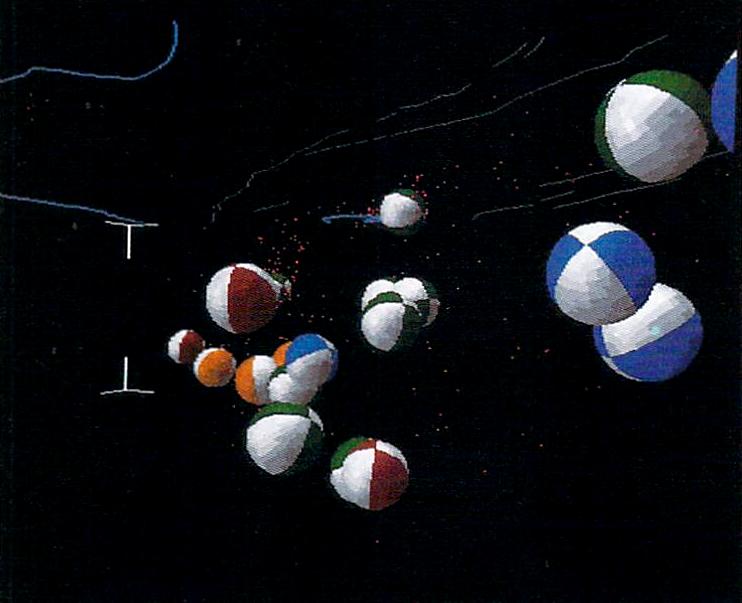
3-D "beach balls" depict depth and slip information
"There are three things the Amiga does for us," says Klein. "First, it gives us a nice way to present our work to the public. People would rather watch an animation than look at sheets of paper," he explains. "Also, with animation, we can show in a time-lapse way how often earthquakes occur and how they happen over time. We can take data from years of Call It-quakes and present it in a few minutes. This gives us a technique to analyze our data." Finally, the Amiga lets the USGS "look at earthquakes in three dimensions. We can't see ilietit in stereo, but we can animate them and move around ill time."
Animating data
How do Klein and Walter transform the data - collected by a network of over 300 seismic stations in Northern California - into animations? "We use only commercial programs," says Klein. "We haven't done any programming on the Amiga." The process starts with QPlot, a custom program run on a VAX host that assembles the data. The Amiga, linked to the VAX, runs A-Talk III (Oxxi) to emulate a Tektronix terminal. This allows them to plot and save images in IFF format. An Amiga public-domain program, VLT (by Willy Langeveld of Stanford's Linear Accelerator Center), not only allows them to plot in color, but has a complete script language that they use to control the VAX automatically.
For the 2-D animations, Klein and Walter used NewTek's Digi-View to capture terrain maps. They then loaded these backgrounds into Deluxe Paint III, where they labeled the images, added the dots representing seismic activity, and linked the images into an animation. In the case of the 3-D animations, the VAX transformed the data into 3-D coordinates, which they downloaded to the Amiga. They entered camera moves via a text editor and rendered the sequences using Videoscape 3D.
Following the Loma Priem quake, Klein and Walter put together a videotape to present their data to the public. (Copies are available for $19.95 plus $5 shipping from Video Transform, 2450 Embarcadero Way, Palo Alto, CA 94303, 415/494-1529.) Entitled "Aftershocks of the Loma Prieta Earthquake: Computer Animations," the tape contains only Amiga-generated graphics. Klein and Walter used Elan Performer (Elan Design) to assemble and play the stills and animations. Then, says Klein, "We just carried the Amiga to the production facility."
Perhaps the next video won't require a trip to an outside production facility. Walter reports that 90% of the USGS' video work (which includes documentary-type videos as well as computer animations) is now being done at an in-house facility opened last fall. "We got [NewTek's] Toaster just for character generation," says Walter, "but when it came in and we saw how good it was, we changed our plans." The facility is now built around the Video Toaster. Plans for edit control also changed. "We put our $5000 edit controller on the shelf and now use Ami-Link (RGB Computer & Video) instead," says Walter.
The Amiga also helped host tile Menlo lark facility's open house last May. An interactive display - driven by the A2000 and AmigaVision included sequences from the videotape and interviews with scientists. That display apparently served to whet the USGS' appetite for an interactive show to run full-time in the public-display area. Currently, they are awaiting the arrival of an A3000, which they will connect to a laser-disc player and a 32-inch touch-screen monitor.
Paper projects
In the meantime, however, Walter will continue using the Amiga for putting together weekly reports summarizing seismic activity in Northern California. As with the animations, Walter uses A-Talk to emulate a Tektronics screen from which he can capture VAX plots as IFF files. These he loads into Deluxe Paint, where he lays line files over the IFFs and plots earthquake activity. He uses WordPerfect (WordPerfect Corp.) for the document text and CrossDOS (Consultron) to transport the finished product to a fax/modem-equipped IBM. From there, the reports are automatically sent out to about 150 newspapers and institutions. Walter would like to see fax hardware and supporting software for the Amiga, so that he could skip the IBM-transfer step.
Klein would also like to see more product development, adding that "One of the weak spots of the Amiga is that developers don't treat it as a useful scientific tool." On his software wish list is a program such as MacSpin on the Macintosh, or AcroSpin on the IBM. These programs read in points, plot them as you would see them in space, and then let you use a joystick or mouse to rotate and view them from various angles. Let's hope Klein's and Walter's wishes come true, so that the Amiga can continue to find a place in scientific realms.
Dr Pat Doyle
As children, many of us longed to board a rocket, rip through the Earth's atmosphere into space, and discover the unknown. Some of us still do.
Though excitement and exploration are undoubtedly part of it, space travel has other, less glamorous, aspects. Space may be infinite, but a space vehicle is not. Cramped quarters and a lack of gravity (which makes space life roughly like bed rest) cause stress. To stay in condition and prevent atrophy, astronauts must exercise two hours a day, but a mundane exercise plan will only add stress. For these reasons, NASA puts great emphasis on exercise and stress-management programs.
Dr. Pat Doyle was an intern at NASA when he was asked to serve as director of a project to develop an interesting, motivating, and entertaining exercise/stress-management plan. That was five years ago, and Doyle, who is now a professor at the University of Houston, began using his Amiga to look for innovative solutions. Bally and other exercise-bicycle manufacturers donated products to the cause. The result was an array of innovative high-tech games.

Psychologist and developer Pat Doyle
For stress management, Doyle and his staff created sports games in which the user becomes a soccer, base-ball, or football player. Sensors, attached to the body, monitor such things as muscle tension to determine his relaxation level. The more relaxed the person is, the better will be his performance; if a player is tense, his quarterback alter-ego will overthrow the ball.
Inner space
"The last frontier" is not the only place that requires stress management. Recently, Doyle's system has been used at the Shriner's Burn Hospital in Galveston, Texas, where it is helping severely burned children cope with and reduce their pain. His games are also used in psychiatric hospitals and with cancer patients. Doyle feels particular satisfaction in the help his games have given to cancer patients. People who are "panicky and distracted" before playing his games emerge "tranquil and oriented," he says.

Sold!
When Doyle began working with an A1000, he was not a dedicated Amiga user. His success, however, has made him one. He now has seven Amiga 500s. While he wrote his initial games in Amiga Basic and C (with graphics and sound help from Deluxe Paint, Digi-View, and Perfect Sound), he is programming current projects in AMOS.
Using the Amiga, according to Doyle, saved NASA both time and money. Because it is fun to program and handles graphics and sound so well, it is the perfect tool for the job. "The Amiga," he says, "by its nature, invites you to push limits or go beyond them. It has an ability to do new things. It communicates adventure and pushing frontiers." With it, Doyle and his crew did just that. They did not waste any time debating whether or not something was possible. They just did it.
Stanford Linear Accelerator Center
Of the more than 100 Amigas at the Stanford University Linear Accelerator Center (SLAC), about 70 are A500s, used as remote consoles for running the Linear Accelerator control software.
But Amigas are by no means relegated to menial tasks. At SLAC, a Department of Energy-financed lab, scientists do theoretical and experimental research in high-energy particle physics - often using A2000s and A3000s. About 40 of these higher-end Amigas are networked with IBM mainframes and VAX systems to act as workstations and terminals. Ten of them are used in the Director's office and the Theory Group, of which theoretical physicist Marvin Weinstein is a member.
"What toys can I show you here?" says Weinstein, clicking through windows on his Amiga screen. He brings up one utility after another, programs that he and colleague Willy Langeveld - who splits his time between the computer science and experimental physics departments - have written using C and ARexx. These programs do a variety of tasks, many of them automating the process of interfacing with the mainframes.
But custom "toys" are not the only Amiga programs SLAC scientists use. One of the commercial programs widely used at the site is Maple (Waterloo Maple Software), which is available on a number of computer platforms. Maple, a so-called "computer algebra system," is popular among engineers, mathematicians, and other scientists for its symbolic and numeric computation, mathematical programming, and mathematical visualization capabilities. Weinstein uses it for his work in high-energy physics theory and claims that it is "more powerful than Mathematica," a much-revered program that's available on other platforms.
SLAC has a site license for Maple on all platforms (except NeXT for which a version does not yet exist). "I use Maple on both the mainframe and Amiga," says Weinstein. He likes to do his writing and debugging on the Amiga because of its "nice, interactive environment." For speed in running tasks, he switches to the mainframe.
How do you do?
One of the projects Weinstein has been working on recently involves finding new tools for problem solving. "There are a number of tools we use in various areas of physics," he says. "One of those is perturbation theory, where we look at a problem and realize that it is similar to a problem we already know how to solve. So, using systematic techniques, we make small corrections In the solution we know, to get closer to the solution we want. This is a tool we use to analyze orbit problems for satellites, or to solve quantum mechanics problems," he explains.
"Increasingly, however, we come across problems that cannot be solved through perturbation theory or other available tools. So we need to develop new tools to address these problems. It is really like banging your head against the wall," he laughs...
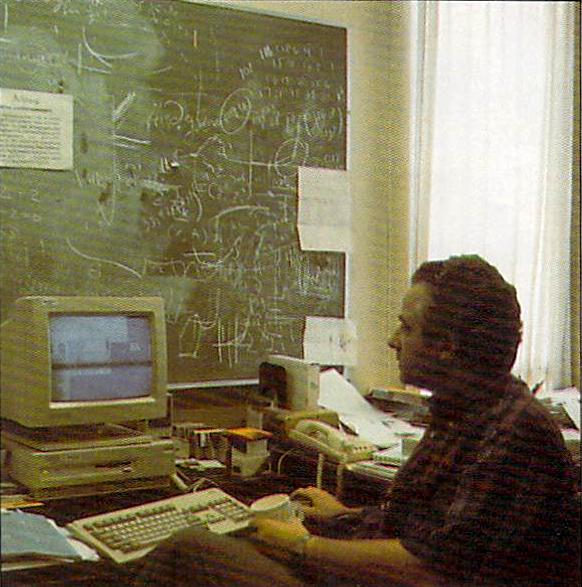
Theoretical physicist Marvin Weinstein
"What really sold us [on the Amiga] was something that is often underrated: its multitasking capabilities," Weinstein remarks. SLAC started with A1000s before the facility was networked. "The Amiga allowed us a symbiotic relationship and transfer capabilities with the mainframe. It also had a terrific Rexx implementation. We could do things on it that we couldn't easily do on other platforms."
Weinstein says that the Amiga's cost-effectiveness "is by no means trivial." Even the A3000, he says, is still quite economical. But, he stresses, it will have to stay that way. There is pressure from above, he explains, with prices dropping on high-end workstations.
For the "really serious work, we use RISC-based systems" he says, because "they give the most MIPS per dollar." But, he laughs, "not everyone can afford have a $30,000 computer on his desk. We are going to buy more A3000s."
Dr. Demetrios Katsaros
Although Commodore has yet to target the medical community, a resourceful, hardcore group of doctors is breaking new medical ground with Amigas. Among them is Dr Demetrios Katsaros, surgical resident at Fairview General Hospital in Cleveland, Ohio.
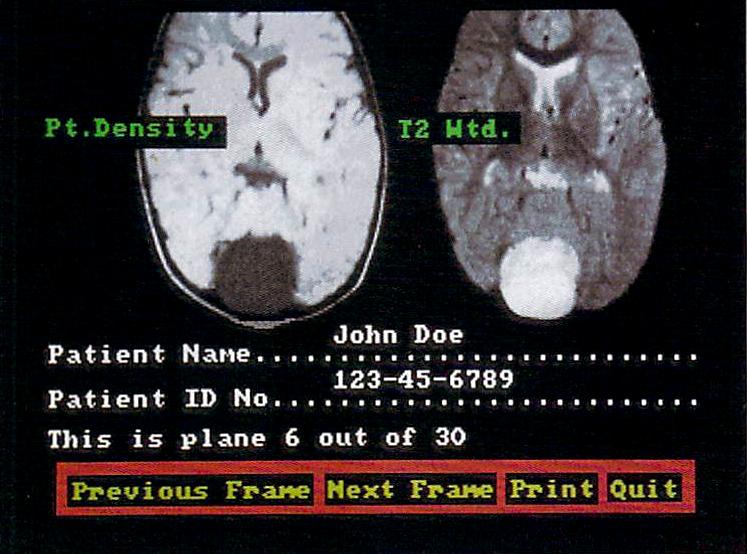
A brain scan - scanned into Dr. Katsaros's Amiga
With the help of INOVAtronics' CanDo authoring system. Katsaros can navigate through a system of scanned images, point to an area such as the liver, and then zoom in or get different perspectives.
So far, he has scanned over 100MB worth of images, including echocardiographic data and an assortment of pathology-, radiology-, and anatomy-related images. He has also brought in sound data on such things as heart murmurs.
To manage all this information, Katsaros recommends Superbase 4 (Precision/Software Publishing), because it is compatible with Mac and PC data files and supports sound and graphics data.
The Amiga also helps Katsaros keep tabs on patients from his home. With his serial port and modem, Katsaros brings in live data from the intensive-care unit or general wards for analysis. Although he can do quite a bit with what he has, he is not totally satisfied with Amiga software offerings. He uses the Commodore Bridgeboard to run PC-based AI software, including QMR, DxPlain, and MEDAS, all of which help in diagnosis, and to do optical character recognition. He uses A-Max to run a Mac-based AI program called Iliad, which is also diagnosis-oriented. He would like, however, to run such software directly from the Amiga.
Katsaros is dissatisfied with the current resolution of the Amiga, as well, and is eagerly awaiting a 24-bit display product that supports a broad array of software.
Come together
The energetic Katsaros has quite a bit of advice for medical-profession Amigans. For those not ready to do their own scans, he points to Amiga-based public-domain software for converting 24-bit images (PET, MRI, and CT) from Siemans or GE imaging systems into Amiga IFF files. These programs are available from the Fred Fish public-domain software and shareware collection. Write to the Fred Fish Catalog Disk Update, 1835 E. Belmont Drive, Tempe, AZ 85284.
Katsaros is a proponent of resource sharing, and advises those in the medical community to hop onto a medical/scientific BBS and join a medical computer club, one of which he happens to run. In fact, Katsaros's Medical Computer Club boasts 120 members. (Those interested in joining can write to Katsaros at 1457 Mayfield Rd., Cleveland, OH 44106 or contact him through CompuServe at 72717,3611.).
Katsaros is also setting up a BBS, through which he plans to provide medical images along with access to other nets. Finally, he also publishes a newsletter. It may seem as though Katsaros has accomplished a lot with his Amiga. but the good doctor says he's "only just beginning."
|












